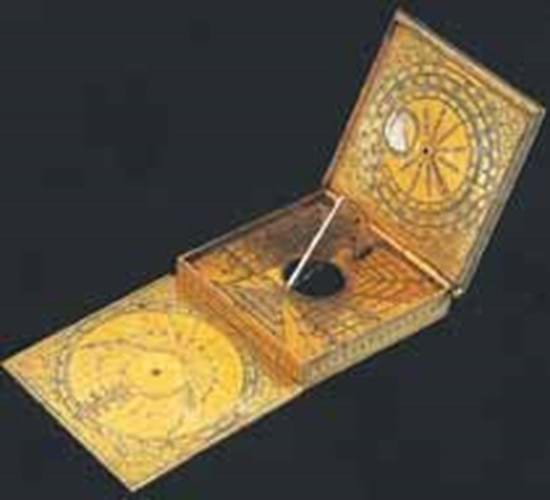
With such a varied bill, it is perhaps not surprising to see that some fields were more popular than others. Natural history specimens struggled, as did scale models of road vehicles and telescopes for example, while weights, measures, pharmacy wares and the microscopes proved easier to shift and there was a strong performance from a better than average selection of globes of various sizes. The result was a take-up by lot of 69 per cent for a net total of £307,120.
The main contribution to that figure came from an attractive Renaissance instrument, the mid-16th century German gilt brass astronomical compendium pictured right. Made by the Augsburg-based Christoph Schissler, signed and dated 1556, this multi-functional piece included a magnetic compass, nocturnal and tables for determining the age of the moon and the time of day and had the high degree of craftsmanship that typifies the work of this renowned maker. The piece also boasted a good provenance, having been part of the collections of the Austrian branch of the Rothschild family. These were confiscated by the Nazis during the war and upon their restoration to the family in 1999 were offered for sale at Christie's in London. On that occasion the compendium fetched £80,000. This time around it managed to make £105,000 despite coming back onto the market after just five years and reappearing without the attendant brouhaha of a high-profile, single-owner sale.
A 26-lot globe section which featured a mix of dates and sizes from library to pocket examples saw a two-thirds take-up topped by a pair of 17th century 10in (25cm) diameter Italian table globes by Mattheus Greuter. At £35,000 the price was somewhat under estimate, perhaps because there was a degree of discolouration and wrinkling to both models.
The prices for pocket globes seemed quite bullish at this event with, for example, a rare early 18th century English terrestrial example signed C. Price Fecit 1701, measuring 2 3/4in (7cm) in diameter, coming in at a double-estimate £8800 and an example by Nathaniel Hill, 1754, making £5000.
At the other end of the scale was a late 18th century Cary's celestial library globe, 21in (53cm) in diameter. This was notable for the constellations featured which a printed inscription described as The whole of the Stars and Nebulae contained in the Astronomical catalogue of the Rev. M Wollaston compiled from the authorities of Flamsteed, De La Caille, Hevelius, Mayer, Bradley, Herschel, Maskelyne & C with an extensive number from the works of Miss Herschel, the whole adapted to the Year 1800. This was contested by two determined bidders to a treble-estimate £17,000.




